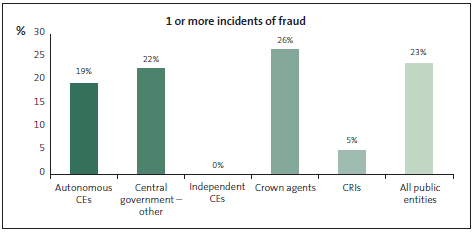Part 3: Incidents of fraud
Despite our generally "clean" image, fraud is a fact of business life in New Zealand. Respondents from autonomous Crown entities, central government – other, Crown agents or companies, and Crown research institutes were aware of at least one incident of fraud or corruption in their entity within the last two years.

Independent Crown entities could not recall any incidents of fraud in the last two years. For this reason, independent Crown entities are not included in the following discussions.
Those who knew of an incident in the last two years were asked for details of the most recent incident. Most of the fraud incidents in these entities were committed by one internal person acting alone, typically at an operational staff or admin support services level.
The value of the most recent fraud noted by respondents was mostly low, with many either reporting no monetary loss or reporting values below $1,000. For some types of entities, up to 90% of respondents said loss through fraud was under $10,000. This trend of low dollar values was common to all sectors in our survey.
The most frequent types of fraud within Crown agents or companies were:
- fraudulent expense claims (27%);
- false invoicing (19%);
- theft of cash (15%); and
- conflicts of interest1 (15%).
The most frequent types of fraud within autonomous Crown entities were:
- fraudulent expense claims (25%); and
- fraudulent misuse of a credit card (17%);
The most frequent types of fraud within central government – other were:
- theft of cash or inventory (30% combined);
- fraudulent misuse of a credit card (15%);
- payroll fraud (15%);
- supplying false credentials (15%); and
- conflicts of interest (15%).
The two respondents who were aware of at least one incident of fraud in Crown research institutes said that the incidents involved providing false information or fraudulently altering documents. Respondents said that the perpetrators left (one was dismissed and one resigned) without the fraud being reported to the authorities. The fraud incidents were discovered by internal control systems, and there was no monetary loss for the most recent incident.2
The most common reason why fraud occurred for all these entities was that the perpetrator did not think they would get caught, and it occurred because internal control policies and procedures were not followed (Crown agents or companies 22%, autonomous Crown entities 30%, and central government – other 40%).
Internal control systems were all of these entities most successful mechanism for detecting fraud. Internal tip-offs (other than through a formal whistle blowing system) was the next successful mechanism for detecting fraud (Crown agents or companies 24%, autonomous Crown entities 15%, and central government – other 17%).
Respondents said that none of the fraud incidents were detected by the external auditor. This is not surprising, because detecting fraud is neither the purpose nor the focus of an external audit.
Questions 32 to 40 in Appendix 1 set out the survey response data about incidents of fraud.
1: Conflicts of interest include making or receiving payments, or receiving undeclared gifts or services, to influence a decision or give preferential treatment.
2: These two incidents appear in the relevant tables in Appendix 1 but have not been included in the graphs because to do so would be misleading.
page top